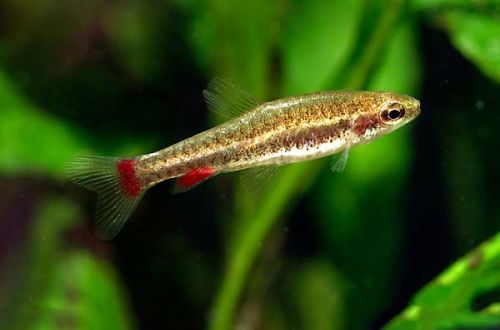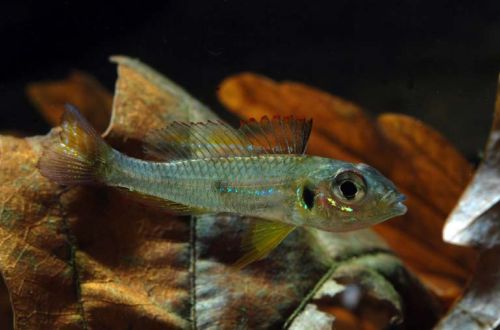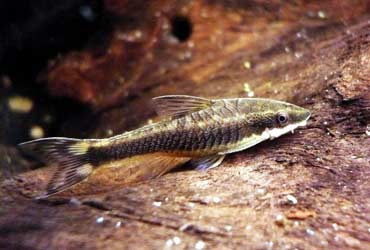
Nannostomus Anduzi
Nannostomus Anduzei, scientific name Nannostomus anduzei, belongs to the Lebiasinidae family. The fish is named after the Venezuelan biologist and explorer Pablo Anduse, who first described this species of fish in detail. Not an easy fish to keep and breed, mainly because of its small size. For the same reason, difficulties arise with the choice of neighbors in the aquarium.

Contents
Habitat
Comes from South America. Wild populations are found in the vast Amazon and Orinoco river basins. The typical habitat is small shallow streams with clear water up to half a meter deep, flowing among tropical forests. The channel contains a sandy substrate, numerous snags and fallen leaves. Dense aquatic vegetation occurs in patches along the coast.
Brief information:
- The volume of the aquarium – from 40 liters.
- Temperature – 22-28°C
- Value pH — 5.0–7.0
- Water hardness – 1–8 dGH
- Substrate type – any
- Lighting – subdued, moderate
- Brackish water – no
- Water movement – little or no
- The size of the fish is about 2 cm.
- Food – any food
- Temperament – peaceful
- Content in a group of 10 individuals
Description
Miniature fish, the size of which does not exceed 2 cm. Sexual dimorphism is weakly expressed. Adult males can be distinguished from females by red pigmentation on the anal fin and tail. The color is gray or sandy, the belly is silvery.
Food
Due to their modest size, Nannostomus Andusi need very fine food, which is usually used for feeding fry, for example, Artemia nauplii or dry flakes, granules ground to small particles.
Maintenance and care, arrangement of the aquarium
It is fashionable to keep a flock of 10 fish in an aquarium with a volume of 40 liters or more. The design is based on aquatic plants and driftwood in the form of tree branches and roots. A useful addition will be the dried leaves of some trees that cover the bottom. When the leaves decompose, tannins are released, giving the water a chemical composition similar to that in which fish live in nature.
When keeping, it is important to ensure stable water conditions in the allowable range of hydrochemical values and temperatures. It is necessary to regularly clean the aquarium, replace part of the water with fresh water weekly and monitor its main indicators: pH, dGH, concentration of products of the nitrogen cycle. Of the mandatory equipment, one can single out a heater and a lighting system that is vital for plant growth. In a small tank, it is perfectly acceptable to use a simple airlift filter with a sponge as the filter media.
Behavior and Compatibility
Peaceful schooling fish, which should be in a large group of at least 10 individuals of both sexes. In small aquariums, representatives of other species should not be settled. If Nannostomus Anduzi are kept in large tanks, then other calm fish of a comparable size will do as neighbors.
Breeding / breeding
Reproduction of this species in an artificial environment is possible, however, due to the tiny size of the fish themselves, and especially the fry, it is not easy to grow the latter to an adult state, especially for beginner aquarists. Parental instincts are not developed, Nannostomuses do not care about their offspring. There is no breeding season, so fry can appear at any time. If they are not transplanted in time, they will soon be eaten, which happens often, since it is very easy to miss the moment of spawning, and it is difficult to notice the fry among the thickets of plants. Another problem is the choice of suitable food and feeding. Specialized powdered feeds are used, from which a suspension is formed in water. Uneaten leftovers lead to a new problem – pollution. Thus, the breeding process is complex and involves a number of difficulties that a novice aquarist may not be able to solve.
Fish diseases
Diseases inherent in this particular species of fish were not noted. When kept in suitable conditions (high water quality, balanced diet, non-conflict neighbors, etc.), health problems are not observed. The most common cause of disease is the deterioration of conditions leading to immune suppression, which makes the fish susceptible to infections that are invariably present in the surrounding area. When the first signs of an illness are detected (lethargy, exhaustion, refusal of food, lowered fins, etc.), it is necessary to immediately check the main parameters of the water. Often, the restoration of acceptable living conditions contributes to self-healing, but if the fish is too weak or has received obvious damage, medical treatment will be required. For more information on symptoms and treatments, see the Aquarium Fish Diseases section.





